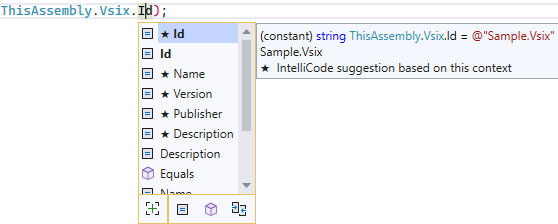Sometimes it’s useful to render VSIX manifest metadata in logs, or some UI in your extension. You could just duplicate the values in your code, but that’s error-prone and tedious.
The ThisAssembly.Vsix package can help you avoid that by generating a
ThisAssembly.Vsix class with all the metadata from your VSIX manifest.

In addition to making the VSIX manifest metadata
properties available as constants, the package also provides targets for those properties
with sensible defaults from project properties so that the manifest can leverage
placeolder syntax
and avoid duplication in the source.extension.vsixmanifest:
<PackageManifest Version="2.0.0" ...>
<Metadata>
<!-- You can use the |ProjectName;TargetName| syntax throughout this manifest, BTW -->
<Identity Id="|%CurrentProject%;VsixId|" Version="|%CurrentProject%;VsixVersion|" Language="|%CurrentProject%;VsixLanguage|" Publisher="|%CurrentProject%;VsixPublisher|" />
<DisplayName>|%CurrentProject%;VsixDisplayName|</DisplayName>
<Description>|%CurrentProject%;VsixDescription|</Description>
</Metadata>
...
</PackageManifest>
The available properties and their default values are:
| Name | Default Value |
|---|---|
| VsixID | $(PackageId) or $(AssemblyName) |
| VsixVersion | $(Version) |
| VsixDisplayName | $(Title) |
| VsixDescription | $(Description) |
| VsixProduct | $(Product) |
| VsixPublisher | $(Company) |
| VsixLanguage | $(NeutralLanguage) or ‘en-US’ |
As shown in the example above, the syntax for using these properties from the source.extension.vsixmanifest is
|%CurrentProject%;[PROPERTY]|. This is because the package defines a corresponding target to
retrieve each of the above properties. You can provide a different value for each property via
MSBuild as usual, of course.
Since the $(PackageId) property can be used as the VSIX ID, the Pack target is redefined to
mean CreateVsixManifest, so “packing” the VSIX is just a matter of right-clicking the VSIX
project and selecting “Pack”.
Happy extending!
/kzu dev↻d